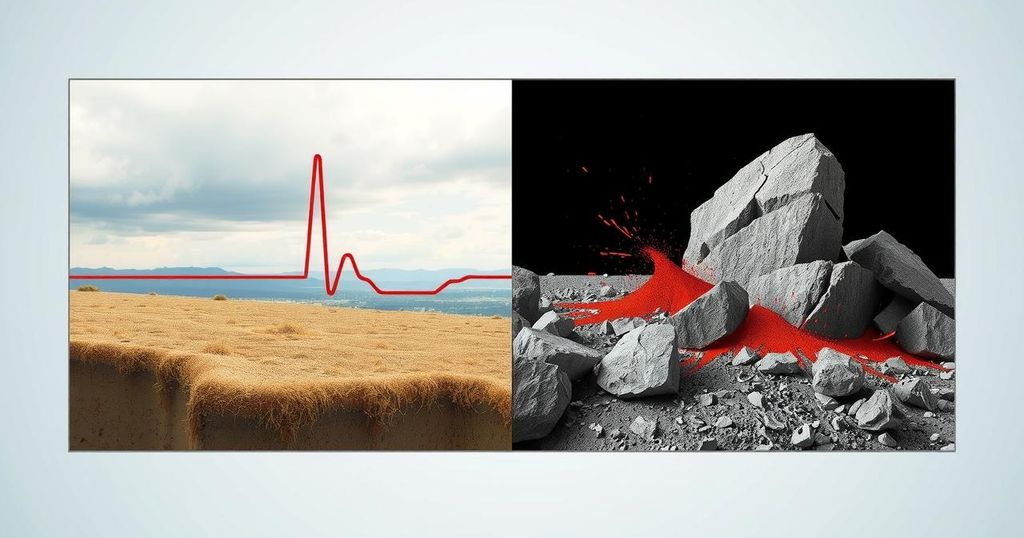A recent study revealed that a 4.5 magnitude earthquake in Iran was not caused by a nuclear test, debunking widespread claims. Conducted by experts from Johns Hopkins University, the findings emphasize the risks of misinformation during geopolitical crises and illustrate the natural seismic processes at play. The research calls for improved communication among scientists to counter false narratives.
Recent research has clarified that a 4.5 magnitude earthquake in Iran was not a result of a nuclear test, as had been speculated by various social media and mainstream news sources. Conducted by an American research team and published in the journal Seismica, the study emphasizes the dangers of misinterpreting scientific information, especially during geopolitical tensions. The research findings underline the necessity of accurate scientific communication in crisis situations.
Led by Dr. Benjamin Fernando, a seismologist at Johns Hopkins University, the study analyzed seismic data from the earthquake that struck on October 5, 2024, near Semnan, Iran. The investigation revealed that the earthquake resulted from natural seismic activity along a fault line, contradicting claims of a nuclear test. Dr. Fernando noted that misinformation surrounding the event highlighted the pivotal role of geophysical data during geopolitical crises.
The researchers utilized publicly available seismic monitoring data, concluding the quake’s origin was linked to the tectonic collision of the Arabian and Eurasian plates. Seismic waves provide crucial information about their source, revealing that the earthquake was caused by a reverse fault motion indicative of natural seismic activity rather than an explosive nuclear test.
Historical seismic data further supports the study’s findings, with the Comprehensive Test Ban Treaty Organisation (CTBTO) reporting similar earthquakes in the region in 2015 and 2018, both unrelated to nuclear activities. Despite scientific evidence, speculation of a nuclear test arose rapidly on social media shortly after the earthquake. Misinterpretations of data, exacerbated by conspiracy theories linking this incident to another event in Israel, proliferated within hours.
Dr. Fernando remarked on the role of initial misinterpreted tweets that escalated into a misinformation campaign about a potential nuclear test. Some of the most widely distributed false theories were connected to accounts linked with Russian-supported disinformation efforts. The narrative transitioned quickly from social media to international news coverage, with numerous media outlets, particularly from India, referencing each other’s erroneous reports and citing flawed data.
To mitigate the impact of such misinformation, the research team advocates for prompt collaborations among seismologists to clarify and correct misconceptions regarding seismic data. Dr. Saman Karimi, a co-author of the study, suggested that scientific agencies should swiftly disseminate reports to counteract misleading narratives and collaborate with social media platforms for improved communication.
Dr. Karimi emphasized the importance of promoting content from verified scientific sources to enhance the credibility of information shared online. Her recommendations underline the value of establishing partnerships between experts and social media entities to ensure factual data dissemination during times of crisis.
The article addresses a significant event in Iran involving a recent earthquake that aroused suspicions of being a nuclear test. As geopolitical tensions mount in the Middle East, misinformation regarding natural disasters can spread rapidly, especially over social media. The necessity for accurate scientific communication becomes critical in preventing the misinterpretation of seismic activities and ensuring public understanding of such phenomena. This research highlights ongoing concerns about the intersection of science, misinformation, and international relations.
In summary, the recent study clarified that the earthquake in Iran was a natural occurrence and not connected to nuclear testing, disproving widespread misinformation. By analyzing seismic data, researchers provided evidence that incorrect interpretations fueled suspicions based largely on conjecture and conspiracy theories. This research underscores the importance of timely scientific communication and the need for collaboration to combat misinformation effectively.
Original Source: www.fox28spokane.com






